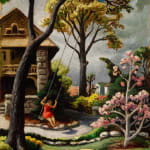Thomas Hart Benton 1885-1975
Framed dimensions: 15 3/4 x 13 inches
Inscribed on verso: Jessie
A champion of rural America, Thomas Hart Benton defined American Regionalism through artwork that was honest and approachable. He eschewed style and artistic trends and instead consistently focused on his forthright manner of painting the working-class communities of rural America, specifically the Midwest.
Benton was born in Missouri to a politically connected and wealthy family. He began his artistic training in defiance of his family’s wishes. With only his mother’s support, he became a cartoonist for the Joplin American Newspaper in Missouri. He eventually enrolled in the School of the Art Institute of Chicago, where he studied for two years before decamping to Paris. While in Paris, Benton advanced his artistic skills and met such artists as Diego Rivera and Stanton MacDonald-Wright. Upon his return to the States, he moved to New York City, where he painted full time and taught at the Art Students League. He was aware of the New York art scene but found himself at odds with its fascination with modernism and other avant-garde art movements and ideas.
In the 1930s Benton fully committed to American Regionalist painting, and along with John Steuart Curry and Grant Wood became a leading practitioner of the distinctive style. He traveled all over the United States but focused mostly on the Midwest. He spent months at a time living in rural midwestern communities, where he connected with the locals in the hope of better capturing their everyday lives. He uses his work to promote his core belief that progress was dependent on the work of the people, and he used his powerful painting style to exalt the American worker / farmer. Benton made thousands of sketches and drawings that would later become finished paintings or murals.
In 1935 after spending two decades in New York City, Benton returned to Kansas City, where he took a teaching job at the Art Institute. He worked there for five years and continued to paint the rural scene. He remained as outspoken about art as ever. But in the lead up to and aftermath of the Second World War, American life changed dramatically. By the time the war ended, the United States emerged as a super power and the interest in Benton's rural America had largely vanished.
Beginning in the 1940s and until his death, Benton increasingly turned inward to his private life and also to history for his subject matter. He painted his daughter Jessie and gave her a painting on her birthday annually for years. This small painting shows Jessie outside the family home in Kansas City on a swing. Benton uses his signature painting style to energetically capture the private moment. The composition, color, and line are distinctively characteristic of his artistic vision. Yet the intimacy of the subject and place confer a feeling of tenderness and beauty to the scene.
Provenance
The artist;By descent in the family to the artist's grandson, 2025



